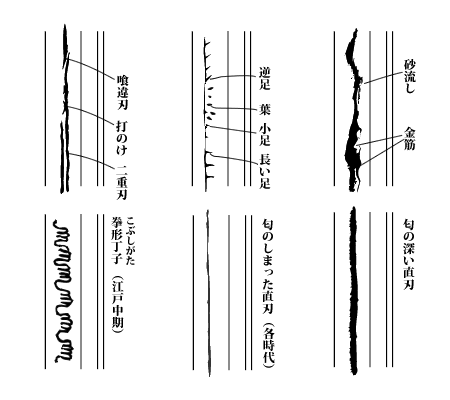刀剣の鑑賞ポイント(愛知県名古屋市千種区姫池通 骨董買取 古美術風光舎)
2024.06.13
みなさまこんにちは、スタッフYでございます。
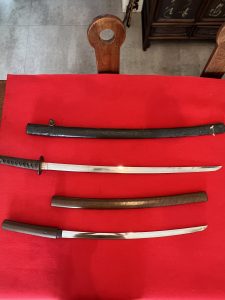
先日は、ご自宅やご実家にて刀剣を見つけてしまった際の取扱いや届け出などについてお伝えいたしました。かつては武器や賜りものなどとしての存在だった刀剣でありますが、現在の刀剣は主に鑑賞用でありましょうか。
博物館などを訪れた際に、もう少しその鑑賞のポイントを理解していくと、もっとその面白さや素晴らしさが理解できるんだろうな…と、思うこともあるのでは。本日は、その刀剣の鑑賞ポイントを綴ってまいりたいと思いますので、お手持ちの刀剣や美術館など、鑑賞をする際に是非参考にしてみてください。
1.姿(すがた)をみる。
日本刀の持つ、機能を追求し一切の無駄を省いた姿に美を感じる方は多いと思います。その姿や反り格好は、制作された歴史の中で、それぞれの必要性に応じて生まれ、その歴史や時代の思潮や様相を物語っています。
2.地鉄(じがね)をみる。
研ぎ澄まされた地鉄に美を見出し、その魅力に惹きつけられる方も多いことでしょう。日本刀は「折れず、曲がらず・よく切れる」という条件を満たすために、良質の玉鋼(たまはがね)を用いて何回も折り返し鍛錬し、炭素量の少ない心鉄(しんがね=軟らかい鉄)を炭素量の多い皮鉄(かわがね=硬い鉄)で包んで強靭な地鉄を作り出します。そのようにして現れる地鉄の模様は、樹木の木肌にたとえられ「板目肌」「柾目肌」「杢目肌」「綾杉(あやすぎ)肌」などと呼ばれ、様々な魅力を秘めています。
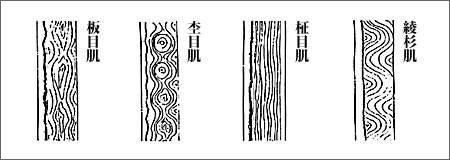 (刀剣博物館HPより)
(刀剣博物館HPより)
一番多いのが板目肌なのですが、正宗で有名な相州物(=現在の神奈川県あたりで作られた刀)に多く見られます。また板目の目がよくつんだ小板目肌は鎌倉時代の山城(=現在の京都府)刀工に多く、特に細くきれいにつんだものを梨子地(なしじ)肌と呼び、さらに江戸末期(幕末)の刀は肌目がよくとらえられないぐらいにつんでいることから、無地肌や鏡肌(かがみはだ)と呼んでいます。
また、杢目に特色を示すのが備中(=現在の岡山県)青江(あおえ)派であり、柾目肌は大和物(=現在の奈良県で作られた刀)の特色とされています。 さらに映(うつ)りといって、刃文とは別に、地の中に白く刃文の影のように霞(かすみ)がかかったものが浮かびあがって見える場合があります。この映りの最も美しいのは備前刀であり、大きな見どころとなっています。
3.刃文(はもん)をみる。
日本刀の美と言えば、姿や地鉄とともに「刃文」の美しさを挙げなければなりません。刃文とは、焼入れの技術によって生ずる模様のことです。焼刃土(やきばづち)という粘土性のものをへらを用いて刀身に土を塗るのですが、塗り方で直刃(すぐは)になったり、乱刃(みだれば)になったりと、刃文の形が決まります。これを土取(つちとり)と言います。
土取の土が乾いたところで炉に入れ、刀身の焼加減を見て水槽に入れます。これを焼入れと言い、最も技量を要する大切なものと言われています。刃文の文様は、制作された時代・刀工の系統・特色をよく現し、様々に変化した魅力があります。
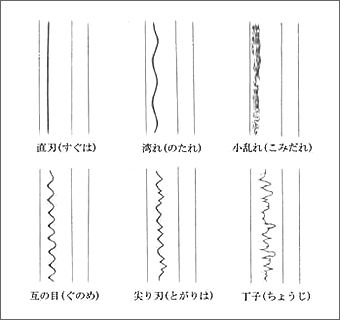 (刀剣博物館HPより)
(刀剣博物館HPより)
また、刃文には焼き入れによって生じる沸(にえ)、匂(におい)があり、これは秋の夜空に輝く星のようにきらきらと見えるものが沸、またかすんだ天の川を望むように見えるものを匂などと言われています。
これらは刀工の美意識の集約とも言え、 刃中の沸の多い作風を「沸出来(にえでき)」と言い、主として鎌倉初期の作刀や相州物(そうしゅうもの)の系統に見られます。「匂出来(においでき)」の作風は、鎌倉中期以後の備前物(びぜんもの)や南北朝時代の備中青江物(びっちゅうあおえもの)などに代表されます。(沸は粒子の粗(あら)い部分で、肉眼でとらえることができますが、匂は顕微鏡で見てやっとわかるほど粒子が細かいものです。)
また、「働き」と言われる景色があります。例えば、刃中の沸がつながって細い線となり、いっそう輝いてきらりと光って見えるものを金筋、やや太く長いものを稲妻(いなづま)と呼んでいます。同様のものが地肌にある場合は地景(ちけい)、沸が一部分に固まった飛焼(とびやき)があります。他にも、刃中に現れる足(あし)・葉(よう)・砂流(すなが)し,など見所が多い部分であります。
4.刀身彫刻をみる。
刀身に彫刻を施すことは、すでに平安時代から行われていました。実用からのもの、信仰によるもの、装飾的なものがあり、時代の流行や系統によって特色が見られます。古刀では樋を掻く(=刀身に沿ってみぞを入れる)ほかに信仰を示す彫刻が多く、梵字(ぼんじ)、剣、不動明王、倶利迦羅(くりから)、三鈷(さんこ)剣、護摩箸や、八幡大菩薩、南無妙法蓮華経などの文字があります。新刀になると、ますます装飾性が強くなり、鶴亀、上下竜、松竹梅、などが彫られています。
どうでしたでしょうか?、刀剣を鑑賞したくなってきましたよね…。銘品などは、特にその姿に悠久の歴史を感じながらも、時に武器であり、信仰の対象ともなり、権威の象徴でもあったのだな…なんて、様々な思いがあふれてきます。
より強く美く鋭利に魂を込めて作られた刀剣の歴史もさることながら、今日まで受け継がれた刀剣の歴史を重ねながら鑑賞しますと、あの光る刃の景色に吸い込まれそうになるのは自分だけじゃないと思うのですが…。刀剣に興味が湧いてきましたら、ぜひこれらのポイントを思い浮かべながら鑑賞してみてください。
それではごきげんよう。
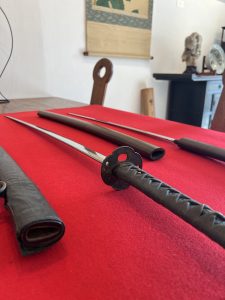
Hello everyone, this is Staff Y.
The other day, we reported on the handling and reporting of swords found at home or at your parents’ house. In the past, swords were used as weapons or gifts, but today’s swords are mainly for appreciation.
When you visit a museum, you may think that if you understand more about how to appreciate swords, you will be able to understand their interest and splendor more. Today, we would like to write about some of the points of sword appreciation, so please refer to them when viewing your swords or visiting museums.
1. Look at the shape of the sword.
Many people find beauty in the form of a Japanese sword, which pursues functionality and eliminates all waste. The shape and warp of a sword are born in response to the needs of each period in the history of the sword’s creation and tell the story of the history and the trends and aspects of that period.
2. Looking at the jitetsu (base iron).
Many people find beauty in the sharpened Jitetsu and are attracted to it. In order to satisfy the requirements of “no breakage, no bending, and good cutting,” Japanese swords are made of high-quality tama-hagane (tama-hagane) and forged over and over again to produce a strong hidetetsu (base iron). The pattern of the iron is called “itame-hada,” “masa-me-hada,” “mokume-hada,” “ayasugi-hada,” etc., and has a variety of attractive characteristics.
The most common type is itame-hada, which is often seen on Soshu swords (= swords made in the present Kanagawa Prefecture), which are famous for Masamune. The most common type is itame-hada, which is found in Soshu-mono (= swords made in today’s Kanagawa Prefecture), famous for Masamune. Ko-itame-hada, with well-deepened itame, is common among Yamashiro (= today’s Kyoto Prefecture) swordsmiths of the Kamakura period, and is called nashiji-hada when the grain is especially thin and clean.
The Aoe school in Bicchu (present-day Okayama Prefecture) is characterized by mokume, while masaime is a characteristic of Yamatomono (swords made in present-day Nara Prefecture). In addition, there is a case in which a white haze, like a shadow of the blade pattern, appears in the ground separately from the blade pattern, called “egori”. The most beautiful of these reflections is found on Bizen swords, and is a major highlight of this type of sword.
3. Look at the blade pattern.
The beauty of Japanese swords is not only in the shape and the iron of the blade, but also in the “hamon” (edge pattern). The haft pattern is a pattern produced by the quenching technique. The shape of the blade is determined by the way the clay called “yakiba-duchi” is applied to the blade with a spatula, and the shape of the blade is determined by the way it is applied, whether it is a straight edge or a midareba edge. This is called tsuchitori. When the clay from the tsuchitori has dried, the sword is placed in a furnace and then placed in a water tank to see how well the blade is burned. This is called “quenching,” and is said to be the most important process requiring the most skill.
The design of the blade pattern is a good indication of the period in which it was made, the lineage of the swordsmith, and the characteristics of the sword, and has an appeal that varies widely.
The blade is said to have “nie” (boiling) and “nioi” (smell), which are produced by the firing process.
The style with a lot of boiling in the blade is called nioi-deki, and is mainly seen in swords made in the early Kamakura period and in the Soshumono lineage. The “nioi-de” style is represented by Bizen-mono made after the middle of the Kamakura period (1185-1333) and Bichu-aoe-mono made in the Nanbokucho period (1392-1333). (Boiling is the coarse-grained part, which can be seen with the naked eye, while odor is the fine-grained part, which can only be seen under a microscope.
There is also a view called “working”. For example, the boiling in the blade is connected to form a thin line, which shines more brightly and appears to sparkle, and a slightly thicker and longer line is called “inazuma” (a kind of “lightning bolt”). Similar effects on the surface of the blade are called chikei, or tobiyaki, in which the boiling is concentrated in one area. Other notable features include the foot, leaf, and sandy flow that appear in the blade.
4. Look at the carving on the blade of the sword.
Carving on the blade of a sword has been practiced since the Heian period (794-1192). There are three types of carving: practical, religious, and decorative, and each type of carving has its own characteristics depending on the fashion and lineage of the period.
In addition to the guttering, many ancient swords were engraved with religious symbols such as Bonji, swords, Fudo Myoo, Kurikara, Sanko swords, Goma chopsticks, Hachiman Daibosatsu, Nam-Myoho-Renge-Kyo, etc. In newer swords, the decoration became more decorative. The newer swords are more decorative, with engravings of cranes and turtles, dragons above and below, pine, bamboo, and plum trees, and more.
What do you think? I hope you have come to appreciate swords….
The swords, especially those with inscriptions, remind us of the long history of the sword, and at times they were weapons, objects of faith, and symbols of authority…….
I think I am not the only one who is almost absorbed by the scenery of those shining blades when I appreciate the history of swords, which were made stronger, more beautiful, sharper and more soulful, as well as the history of swords passed down to the present day….
If you are interested in swords, please try to appreciate them with these points in mind.
Have a good day.
*******************
ご実家の整理やお片付けなどをされている方のご相談などが多くございます。
お片付けなどくれぐれもご無理のないようになさってくださいませ。
風光舎では古美術品や骨董品の他にも絵画や宝石、趣味のお品など様々なジャンルのものを買受しております。
お片付けをされていて、こういうものでもいいのかしらと迷われているものでも、どうぞお気軽にご相談下さいませ。
また風光舎は、出張買取も強化しております。ご近所はもちろん、愛知県内、岐阜県、三重県その他の県へも出張いたします。
まずは、お電話お待ちしております。
愛知県名古屋市千種区姫池通
骨董 買取【古美術 風光舎 名古屋店】
TEL052(734)8444
10:00-18:00 OPEN

